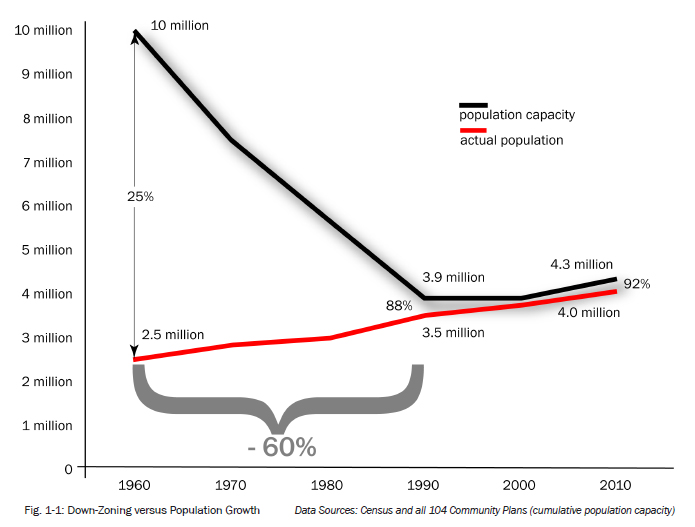Physical Address
304 North Cardinal St.
Dorchester Center, MA 02124
Physical Address
304 North Cardinal St.
Dorchester Center, MA 02124
[This post was originally published on the blog Better Institutions] The people who live in coastal urban cities tend to be a pretty liberal bunch. We’re leading the country on minimum wage laws, paid sick leave, climate change mitigation, and a host of other important issues. We care deeply about equality of opportunity, and we’re willing to invest our time and money to advance that effort—even if the people we help don’t always look like us or come from the same neighborhood, state, or even country. I’m proud to count myself among their number. And then we turn to housing. Maybe it’s just because we’re doing great on so many other fronts, but when I look at our inability to solve the housing crisis in places like San Francisco, New York, and Washington, D.C., I’m left feeling nothing but depression and hopelessness. It’s all the more frustrating because unaffordable housing might be the most important economic problem facing residents of liberal U.S. cities, and we’re perfectly, comprehensively, and unmistakably blowing it. The causes of this failure are too numerous to ever fully enumerate in a single blog post, and, admittedly, some are out of the hands of cities themselves. But I don’t want to be too forgiving—state and federal policy plays a role, for example, but liberal U.S. cities are also typically located in liberal U.S. states, and federal policy applies equally to all, including the cities that have managed to remain affordable. There’s also the impact of global capitalism on a few world class cities, but it’s hard to feel genuine pity for places where foreign investors are willing to dump billions of dollars. Boo-hoo. At it’s heart this is a problem of liberal governance and/or policy, and we need to face it head on. We can’t blame this on someone else. It’s our […]

[This piece was originally published on the site Better Institutions.] On March 7th, Los Angeles is going to vote on the type of city it wants to be. The vote will be over Measure S, formerly known as the Neighborhood Integrity Initiative (NII), which seeks to limit housing development in the city. Backers of the initiative claim that City Council is too beholden to developers, and that the pace of new housing and commercial development in the city is out of control. They also express concern that “mega projects” are making Los Angeles less affordable, since few new homes are being targeted at low and moderate income households. It’s a really bad plan, but calling Measure S “bad” doesn’t go nearly far enough. It is, in fact, the Donald Trump of ballot initiatives. It’s a cynical effort to co-opt a legitimate sense of frustration—frustration felt by those who haven’t shared in the gains of an increasingly bifurcated society—and to use that rage and desperation for purely selfish purposes. It invites us to vent our frustrations and, in so doing, to further enrich those who helped to engineer our ill fortune. And as with Trump, a Measure S victory will roll back the clock on years of steady progress. Since I think there are a lot of folks out there who genuinely haven’t made up their minds about the initiative, or aren’t yet familiar with it, I’d like to summarize some of the most important reasons to oppose it when it comes time to vote this March. 1. IT WILL MEAN FEWER AFFORDABLE HOUSING UNITS FOR LOW INCOME HOUSEHOLDS. The Coalition to Preserve LA, which is backing the initiative, is turning this into a referendum on housing development in Los Angeles. They’re arguing that new homes have “wiped out thousands of […]

In 1986, a foreshadowing of today’s fight over “neighborhood integrity” was taking place, culminating in November as Los Angeles residents voted 2-to-1 to cut the development potential of thousands of parcels across the city. Of the 29,000 acres zoned for commercial and industrial uses throughout LA, 70 percent saw their development capacity sliced in half, from a floor-area ratio (FAR) of 3.0 to 1.5. Since the city allows housing to be built in many of these zones, it didn’t just mean less office, retail, and manufacturing space, but fewer homes as well. The ballot initiative responsible for these changes was called Proposition U, and it’s the reason that so many commercial corridors in LA are still characterized by 1960s and ’70s-era, single-story, dilapidated strip malls. All those arterial corridors were the ones permanently frozen in time by Prop U. THE PROPOSAL To my knowledge no one has ever assessed exactly how much this instance of “planning by the ballot” actually reduced the residential capacity of Los Angeles. By my very, very rough estimate, I would put the number somewhere on the order of 1 million homes.* But whether the actual number is 1 million, 500K, or over 2 million, the conclusion is the same: If we want to keep Los Angeles affordable for residents at all income levels, we should repeal Proposition U. Repealing Proposition U would achieve several important aims. Since we’re talking about arterial, commercial corridors, the repeal would dramatically increase the supply of transit-oriented housing over the next several decades—something we desperately need at a time of record-low residential vacancy rates if we’re to have any hope of limiting continued rent increases. It would reduce development pressures on existing communities, directing development to underutilized corridors with little to no housing on them, rather than funneling developers into single-family neighborhoods […]